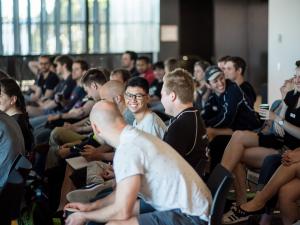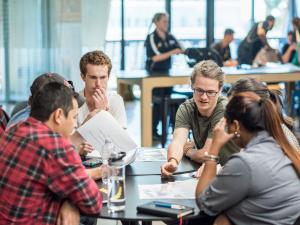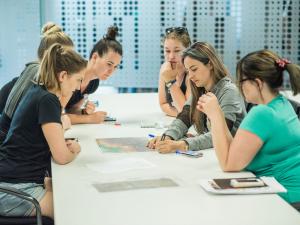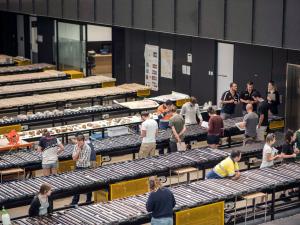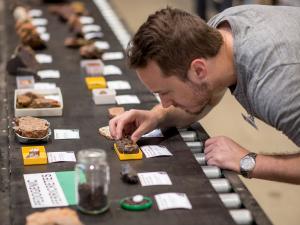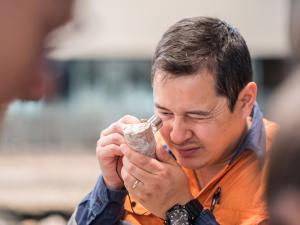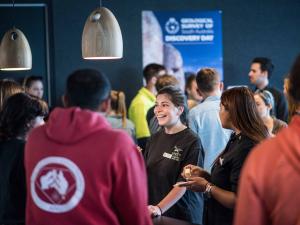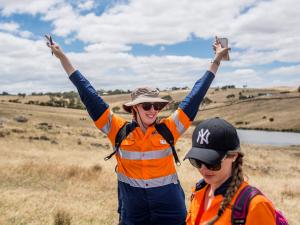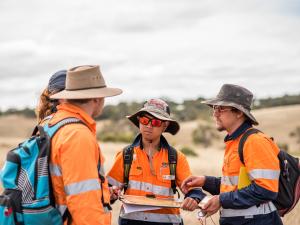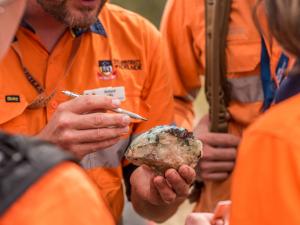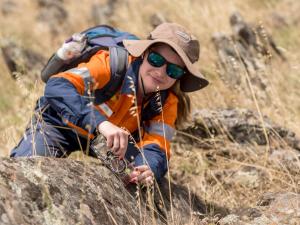2017 NExUS Program Alumni
Highlights of the 2017 NExUS program
The second NExUS in 2017 attracted applicants from around Australia, with 33 securing a place in the course. We had participants from 13 different universities, with every state and territory represented.
November 26th, 2017, marked the commencement of the second year of the National Exploration Undercover School (NExUS). NExUS has put these students on the road to success in the rapidly changing exploration industry. As a result, the next generation of geoscientists entering the workforce has a good chance of bringing about positive change in the industry. NExUS has thus succeeded in its motive for the second year running – here’s to many more years of the initiative!
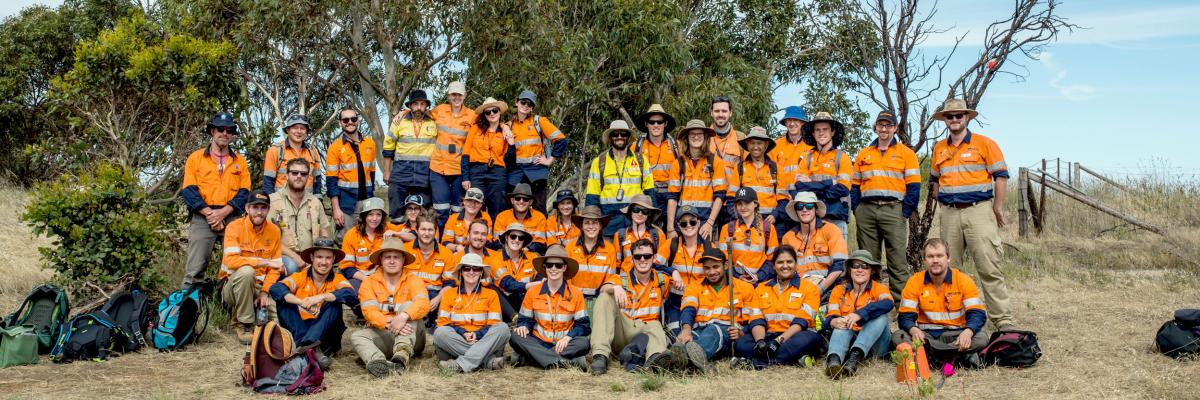
-
2017 program participants
NExUS has put these students on the road to success in the rapidly changing exploration industry. As a result, the next generation of geoscientists entering the workforce has a good chance of bringing about positive change in the industry. NExUS has thus succeeded in its motive for the second year running – here’s to many more years of the initiative!
2017 National Exploration Undercover School attendees, pictured above, rear rows, left to right:
- Richard Lilly - Uni of Adelaide - Mount Isa Mines, NExUS Coordinator
- Craig Crossland - Metals X
- Lena O'Toole - Uni of Sydney - Mount Isa Mines
- Nathan Pritchard - Uni of New England
- Thomas Prentice - Geol Survey of NSW
- Joel Burkin - UWA - Curtin - JCU
- John Arakkal - UWA
- Matt McGloin - NT Geol Survey
- Cassandra Lintvelt - Uni of Adelaide
- Jessica Askew - Macquarie Uni
- Georgie Virgo - Uni of Adelaide
- Deepika Venkataramani - Uni of Newcastle
- Martin Beilharz - Monash Uni
- Danica Beavis - QUT
- James Hewett - Uni of Adelaide - Mount Isa Mines
- Brad Cave - Uni of Adelaide
- Sarah Arnoldi - Curtin Uni
- Ben Spyridis - Macquarie Uni
- Eleisha Pitt - JCU - Rio Tinto
- Hannah Couper - Uni of Tasmania - QUT
- Rebekah Cornelius - Uni of Tasmania
- Adrian Siller - Uni of Queensland
- Geremiah Toledo - Uni of Adelaide
- Shaun Haney - Monash Uni
- Madison Page - Macquarie Uni
- James Parslow - Uni of Newcastle
- Josephine Bailey - Kirkland Lake Gold - Monash Uni
- Steve Hill - Geol Survey of South Australia, NExUS partner
Front row, from left:
- Sebastian Chee Tuck Wong - Uni of Newcastle
- Genevieve Cini - Uni of Melbourne
- Jack Ward - Uni of Queensland
- Damon Symons - Goldfields Australia
- Tristan Wells - Uni of Tasmania
- Samantha Ross - Uni of Sydney
- Courtney Dhnaram - Geol Survey of Queensland
- Jon Berthiaume - Uni of Adelaide - NExUS demonstrator, not pictured
- Emma Beattie - Mount Isa Mines - NExUS demonstrator, not pictured
-
Week one
Week one highlights
Week one kicked off in Tonsley at the South Australian Drill Core Reference Library. The NExUS crew were welcomed aboard their exploratory journey by Robbie Rowe (NextGen), Steve Hill (Geol Survey of South Australia) and Gavin Lind (Minerals Council of Australia). This introduction set the scene for a packed three weeks and motivated the already very eager group of students even further.
Over the course of the ensuing week, these keen students were exposed to the four UNCOVER themes:
- The first theme – ‘characterising Australia's cover’ – was addressed by lectures and exercises focussing on regolith mapping and biogeochemistry by Carmen Krapf (pictured below), Malcolm Sheard and Steve Hill (all GSSA).
- Theme two – ‘Australia’s lithospheric architecture’ – was addressed by talks on the diversity of data sets that can be used in exploration. These talks came from Stephan Thiel and Kate Robertson (GSSA), and Graham Heinson (University of Adelaide).
- Theme three – ‘geodynamic evolution and metallogenesis’ – was expanded upon with an incredible presentation on 4D geodynamics in Victoria, by Ross Cayley (Geological Survey of Victoria).
- Theme four – ‘distal mineral footprints’ – was introduced by Ravi Anand (CSIRO). Core logging and hydrogeology, both hugely important fields of knowledge for a budding exploration geologist, were also covered in week one.
Additional to the core logging exercises, an introduction to hyperspectral techniques was provided, wherein automated core scanning technologies ‘Hylogger’ and ‘Minalyze’ were explained and demonstrated through an interpretation workshop.
Later in the week, the students were introduced to diamond drilling at the Boart Longyear drill testing facility, and explored the potential and outcomes of the Deep Exploration Technologies Cooperative Research Centre (DET-CRC). Both were excellent examples of organisations able to address the need for deep, undercover exploration in Australia.
-
Week two
Week two highlights
Week two took the cohort to the rolling Adelaide Hills, where their new knowledge was expanded upon at Hillgrove Resources Wheal Ellen prospect. The Zn-Ag prospect dates back to the 1850s and was an excellent location for the group to practice a variety of exploration methodologies.
Activities included geochemical soil sampling and a range of geophysical data collection methods including resistivity, induced polarity (IP), gravity, ground penetrating radar (GPR) and transverse electro magnetics (TEM). Students learnt about traditional geological mapping from Callum Fullelove (Mount Isa Mines) and Michael Belperio (Newmont) and discussed the challenges facing exploration geology today from the inspiring Phil McFadden (UNCOVER).
The students were also given an exciting demonstration and talk on drone mapping by Steve Micklethwaite (Monash University). An additional day core logging at Kanmantoo Mine, hosted by Hillgrove Resources, reinforced logging skills gained in the first week and exposed the group to more exciting mineralised rocks. The week also included a field trip to Hallett Cove, where heavy rain failed to dampen Carmen Krapf’s (GSSA) spirits when educating us on the history of the unique location.
the NExUS group had the opportunity to network with professional geoscientists .The week was topped off by an entertaining day at the South Australian Exploration and Mining Conference (SA EMC) where the NExUS group had the opportunity to network with professional geoscientists and listen to a range of excellent presentations on the South Australian minerals industry.
-
Week three
Week three highlights
The final week of NExUS took place in the idyllic Yorke Peninsula, based at the historic Copper Coast town of Wallaroo.
The cohort received workshops on identification of ore and gangue minerals, breccias textures and geochemical exploration by Richard Lilly (University of Adelaide). Students were also treated to a two-session paragenetic logging exercise at Rex Minerals Hillside resource, and a biogeochemistry field session with Steve Hill (GSSA).
Gavin Springbett (G&S Resources) introduced the students to the JORC code and to 3D modelling during a one-day workshop using Maptek Vulcan software.
During the week, the students also visited the Wallaroo Harlequin stone quarry and the Moonta Museum to learn about the legacy of copper mining on the Yorke Peninsula. The students also had the chance to talk with representatives from the Kokatha people and OZ Minerals about how to form positive relationships with traditional owners during exploration and mining activities.
-
Extra activities
During the NExUS course, students were given many opportunities to learn from and network with a wide range of industry professionals. Evenings included informal talks by Glenn Little and Anna Ogilvie (Minotaur Exploration), John Anderson (Investigator Resources), Aaron Baensch (Olympus) and Josh Leigh (AIG). A special evening networking event was also hosted by Laura Tyler (pictured), Kathy Ehrig and Jesse Clark (BHP).
These social evenings gave the students an insight into what it can be like working for a range of different companies; from independent junior explorers to major mining companies.
Alongside an exceptionally high standard of education and networking opportunities, there were periods of free time which allowed space for the students to recuperate and socialise.
Just as it is a national leader in educating the next wave of explorers, NExUS is an unparalleled opportunity for early career geologists to build a professional network. The students were continuously busy getting to know their colleagues - people they will likely work closely with in their forthcoming professional lives. Alongside an exceptionally high standard of education and networking opportunities, there were periods of free time which allowed space for the students to recuperate and socialise.
These periods of relaxation acted as an adhesive of sorts, tying together the weeks of mental stimulation in a way that allowed the students to process, discuss and properly store their NExUS learnings.
Week one offered a day at the Adelaide Ashes (day-night) test match, which was a new experience for locals and non-locals alike. During another rest day, some of the cohort went swimming with dolphins in the Gulf of St. Vincent, while others opted for a more traditional South Australian wine tour in the Adelaide Hills. Week three’s schedule even left room for an optional yoga session and daily swims at the beautiful Wallaroo beach.
The NExUS organisers would like to thank the 60+ professional geoscientists, representing 29 minerals-industry related companies, organisations and research institutions who volunteered their time to be involved in NExUS 2017.
This summary was prepared by Josephine Bailey and Richard Lilly. The original version is published on LinkedIn.

